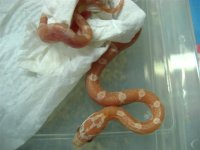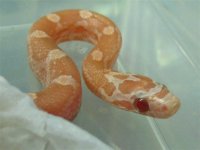proreptile
Proreptile
Hello
I got these guys out of a plasma hetero hypo x plasma . (picture taken wright out of the egg)
Or these guys are hypo plasmas, or it or fire plasmas ( if it should be the fact that the albino gene was sneeking in.. Allthough Rich never got albino effects his litters.
What do you guys think ? The eyes are actually darker then albino eyes.
Besides this, I also got lots of kinking, maybe better to do hetero x plasma next year.
I got these guys out of a plasma hetero hypo x plasma . (picture taken wright out of the egg)
Or these guys are hypo plasmas, or it or fire plasmas ( if it should be the fact that the albino gene was sneeking in.. Allthough Rich never got albino effects his litters.
What do you guys think ? The eyes are actually darker then albino eyes.
Besides this, I also got lots of kinking, maybe better to do hetero x plasma next year.



